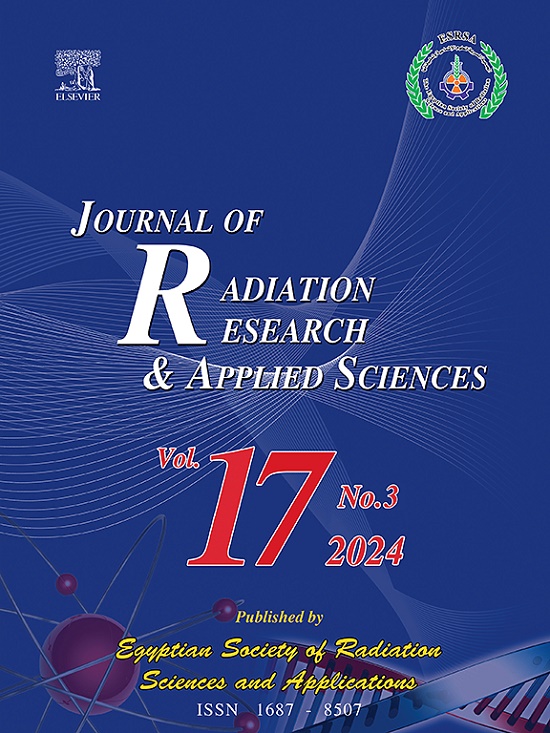基于实验和仿真的沙特阿拉伯水泥板伽马射线屏蔽优化
IF 2.5
4区 综合性期刊
Q2 MULTIDISCIPLINARY SCIENCES
Journal of Radiation Research and Applied Sciences
Pub Date : 2025-08-21
DOI:10.1016/j.jrras.2025.101861
引用次数: 0
摘要
本研究评估了沙特阿拉伯市售水泥板屏蔽伽马射线应用的有效性。利用能量色散x射线光谱学确定了每块板的元素组成,并利用铯-137 (662 keV)和镅-241 (59.5 keV)源实验测试了它们衰减伽马辐射的能力。结果表明,对于662 keV的伽马光子,线性衰减系数在0.0855 ~ 0.1110 cm−1之间,对于59.5 keV的伽马光子,线性衰减系数在0.3760 ~ 0.4752 cm−1之间,表明屏蔽性能中等。这些实验结果与NIST XCOM数据库中的理论值非常吻合,并通过GEANT4蒙特卡罗模拟得到进一步证实。为了达到更好的屏蔽效果,先进的水泥复合材料通过添加高原子序数的氧化物,包括氧化铋、氧化铅、三氧化钨、硫酸钡和氧化铜。模拟结果表明,屏蔽效率显著提高,特别是在光子能量较低时,光电效应占主导地位。在这些增强复合材料中,氧化铅和氧化铋的混合物表现出最高的性能,在59.5 keV下实现了2.42 cm−1的线性衰减系数。这些发现表明,无铅优化胶凝材料可以作为有效的、环境更安全的、结构上可行的替代辐射屏蔽在医疗、核和工业应用。本文章由计算机程序翻译,如有差异,请以英文原文为准。
Experimental and simulation-based optimization of gamma-ray shielding using cement boards in Saudi Arabia
This study evaluates the effectiveness of commercially available cement boards in Saudi Arabia for gamma-ray shielding applications. The elemental composition of each board was identified using Energy Dispersive X-ray Spectroscopy, and their ability to attenuate gamma radiation was experimentally tested using cesium-137 (662 keV) and americium-241 (59.5 keV) sources. The results showed that the linear attenuation coefficients range from 0.0855 to 0.1110 cm−1 for 662 keV gamma photons and from 0.3760 to 0.4752 cm−1 for 59.5 keV gamma photons, indicating moderate shielding performance. These experimental findings closely matched the theoretical values from the NIST XCOM database and were further confirmed through GEANT4 Monte Carlo simulations. To achieve better shielding, advanced cement composites were developed by adding high atomic number oxides, including bismuth oxide, lead oxide, tungsten trioxide, barium sulfate, and copper oxide. Simulation results revealed significant improvements in shielding efficiency, particularly at lower photon energies, where the photoelectric effect is dominant. Among these enhanced composites, the mixture containing lead oxide and bismuth oxide exhibited the highest performance, achieving a linear attenuation coefficient of 2.42 cm−1 at 59.5 keV. These findings demonstrate that lead-free optimized cementitious materials can serve as effective, environmentally safer, and structurally viable alternatives to radiation shielding in medical, nuclear, and industrial applications.
求助全文
通过发布文献求助,成功后即可免费获取论文全文。
去求助
来源期刊

Journal of Radiation Research and Applied Sciences
MULTIDISCIPLINARY SCIENCES-
自引率
5.90%
发文量
130
审稿时长
16 weeks
期刊介绍:
Journal of Radiation Research and Applied Sciences provides a high quality medium for the publication of substantial, original and scientific and technological papers on the development and applications of nuclear, radiation and isotopes in biology, medicine, drugs, biochemistry, microbiology, agriculture, entomology, food technology, chemistry, physics, solid states, engineering, environmental and applied sciences.
 求助内容:
求助内容: 应助结果提醒方式:
应助结果提醒方式:


